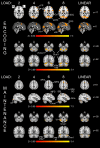Sensorimotor, language, and working memory representation within the human cerebellum
- PMID: 31361075
- PMCID: PMC6865458
- DOI: 10.1002/hbm.24733
Sensorimotor, language, and working memory representation within the human cerebellum
Abstract
The cerebellum is involved in a wide range of behaviours. A key organisational principle from animal studies is that somatotopically corresponding sensory input and motor output reside in the same cerebellar cortical areas. However, compelling evidence for a similar arrangement in humans and whether it extends to cognitive functions is lacking. To address this, we applied cerebellar optimised whole-brain functional MRI in 20 healthy subjects. To assess spatial overlap within the sensorimotor and cognitive domains, we recorded activity to a sensory stimulus (vibrotactile) and a motor task; the Sternberg verbal working memory (VWM) task; and a verb generation paradigm. Consistent with animal data, sensory and motor activity overlapped with a somatotopic arrangement in ipsilateral areas of the anterior and posterior cerebellum. During the maintenance phase of the Sternberg task, a positive linear relationship between VWM load and activity was observed in right Lobule VI, extending into Crus I bilaterally. Articulatory movement gave rise to bilateral activity in medial Lobule VI. A conjunction of two independent language tasks localised activity during verb generation in right Lobule VI-Crus I, which overlapped with activity during VWM. These results demonstrate spatial compartmentalisation of sensorimotor and cognitive function in the human cerebellum, with each area involved in more than one aspect of a given behaviour, consistent with an integrative function. Sensorimotor localisation was uniform across individuals, but the representation of cognitive tasks was more variable, highlighting the importance of individual scans for mapping higher order functions within the cerebellum.
Keywords: cerebellum; fMRI; language; sensorimotor; working memory.
© 2019 The Authors. Human Brain Mapping published by Wiley Periodicals, Inc.
Conflict of interest statement
The authors declare no potential conflict of interest.
Figures





Similar articles
-
An fMRI study of intra-individual functional topography in the human cerebellum.Behav Neurol. 2010;23(1-2):65-79. doi: 10.3233/BEN-2010-0268. Behav Neurol. 2010. PMID: 20714062 Free PMC article.
-
Involvement of the cerebellar cortex and nuclei in verbal and visuospatial working memory: a 7 T fMRI study.Neuroimage. 2012 Sep;62(3):1537-50. doi: 10.1016/j.neuroimage.2012.05.037. Epub 2012 May 24. Neuroimage. 2012. PMID: 22634219
-
Stimulus-Specific Visual Working Memory Representations in Human Cerebellar Lobule VIIb/VIIIa.J Neurosci. 2021 Feb 3;41(5):1033-1045. doi: 10.1523/JNEUROSCI.1253-20.2020. Epub 2020 Nov 19. J Neurosci. 2021. PMID: 33214320 Free PMC article.
-
Universal Transform or Multiple Functionality? Understanding the Contribution of the Human Cerebellum across Task Domains.Neuron. 2019 Jun 5;102(5):918-928. doi: 10.1016/j.neuron.2019.04.021. Neuron. 2019. PMID: 31170400 Free PMC article. Review.
-
The cerebellum and cognition: evidence from functional imaging studies.Cerebellum. 2012 Jun;11(2):352-65. doi: 10.1007/s12311-011-0260-7. Cerebellum. 2012. PMID: 21373864 Review.
Cited by
-
Functional parcellation of the right cerebellar lobule VI in children with normal or impaired reading.Neuropsychologia. 2020 Nov;148:107630. doi: 10.1016/j.neuropsychologia.2020.107630. Epub 2020 Sep 23. Neuropsychologia. 2020. PMID: 32976851 Free PMC article.
-
Data-driven study on resting-state functional magnetic resonance imaging during early abstinence of alcohol dependence in male patients and its predictive value for relapse.BMC Psychiatry. 2022 Feb 22;22(1):143. doi: 10.1186/s12888-022-03782-w. BMC Psychiatry. 2022. PMID: 35193538 Free PMC article.
-
Event cache: An independent component in working memory.Sci Adv. 2025 May 23;11(21):eadt3063. doi: 10.1126/sciadv.adt3063. Epub 2025 May 23. Sci Adv. 2025. PMID: 40408491 Free PMC article.
-
The prominent role of the cerebellum in the social learning of the phonological loop in working memory: How language was adaptively built from cerebellar inner speech required during stone-tool making.AIMS Neurosci. 2020 Sep 16;7(3):333-343. doi: 10.3934/Neuroscience.2020020. eCollection 2020. AIMS Neurosci. 2020. PMID: 32995491 Free PMC article.
-
Volumetric reduction of cerebellar lobules associated with memory decline across the adult lifespan.Quant Imaging Med Surg. 2020 Jan;10(1):148-159. doi: 10.21037/qims.2019.10.19. Quant Imaging Med Surg. 2020. PMID: 31956538 Free PMC article.
References
-
- Atkins, M. J. , & Apps, R. (1997). Somatotopical organisation within the climbing fibre projection to the paramedian lobule and copula pyramidis of the rat cerebellum. Journal of Comparative Neurology, 389, 249–263. - PubMed
-
- Baddeley, A. (1992). Working memory. Science, 255, 556–559. - PubMed
-
- Baddeley, A. (2000). The episodic buffer: A new component of working memory? Trends in Cognitive Sciences, 4, 417–423. - PubMed
Publication types
MeSH terms
Grants and funding
LinkOut - more resources
Full Text Sources

